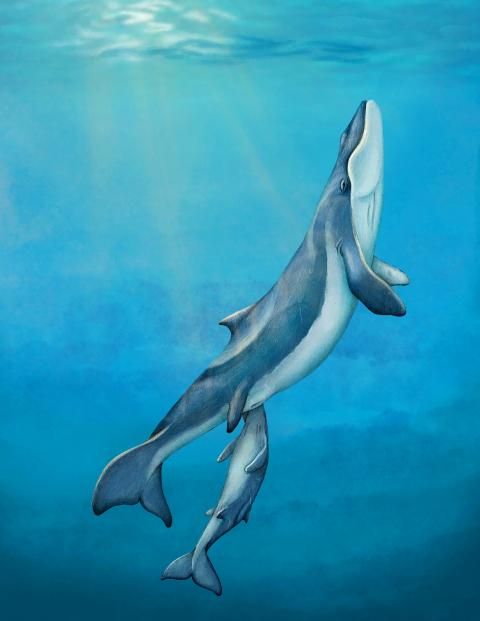A prehistoric 4.5 meter-long whale that sucked prey into its mouth represents a key missing puzzle piece concerning the evolution of today’s huge filter-feeding whales, scientists said on Nov. 29.
The researchers described fossils unearthed in Oregon, US, of a whale named Maiabalaena nesbittae that lived 33 million years ago and possessed neither teeth nor baleen, the material that modern filter-feeding whales use to strain large amounts of tiny prey out of the water for food. They called Maiabalaena, meaning “mother whale,” a surprising intermediate evolutionary stage between modern baleen whales and their toothed ancestors. Maiabalaena consumed fish and squid by sucking them into its mouth.
The evolutionary steps that led to modern baleen filter-feeding giants like the blue whale, Earth’s largest-known animal past or present, had remained unclear. Baleen is a flexible material made of keratin, the same stuff found in hair and fingernails. One leading hypothesis had been that in the early stages of baleen whales’ evolution they possessed both teeth and baleen before later becoming toothless. Maiabalaena’s position on the whale family tree, the researchers said, instead indicates that tooth loss preceded baleens by millions of years.

Photo: Reuters
照片:路透
“This fossil demonstrates that the loss of teeth and the origin of baleen are separate evolutionary changes, and that the two changes did not overlap,” said Nick Pyenson, curator of fossil marine mammals at the Smithsonian Institution’s National Museum of Natural History and author of the book “Spying on Whales.” “Maiabalaena suggests that key evolutionary changes in the way that baleen whales feed, such as the loss of chewing, must have occurred before the innovation of filter feeding,” Pyenson added.
Whales are marine mammals. The first whales evolved from wolf-like land ancestors roughly 50 million years ago. All early whales had teeth. The oldest direct fossil evidence of baleen dates from 11 million years ago, but scientists suspect the first whales with baleen appeared about 23 million years ago.
The fossils discovered near the Pacific coast in Oregon’s Lincoln County showed Maiabalaena boasted well-developed bones in the throat that served as attachment points for muscles that depress the tongue and help produce suction. “Suction feeding may seem strange for an ancestor of today’s blue whales, but it’s actually a very common mode for living toothed whales such as sperm whales and many species of dolphins,” said George Mason University paleobiologist Carlos Mauricio Peredo, a predoctoral fellow at the museum.
The research was published in the journal Current Biology.
(Reuters)
科學家於十一月二十九日指出,一種身長十五呎(四點五公尺)、將獵物直接吸入嘴中的史前鯨魚,就今日的大型濾食性鯨魚演化而言,可說是一塊遺失許久的關鍵拼圖。
從美國奧勒岡州出土的化石中,研究人員描繪出一種命名為「Maiabalaena nesbittae」的鯨魚。它們生活在三千三百萬年前,既沒有牙齒,也沒有鯨鬚,也就是現代濾食性鯨魚用來從水中過濾出大量微小獵物為食的器官。研究人員認為新出土的史前鯨魚—其學名「Maiabalaena」有「母鯨」之意—位處演化史中的過渡期,介於現代鬚鯨和它們的有齒祖先之間,相當令人驚喜。「Maiabalaena」以魚類與烏賊為食,攝食方式是直接將它們吸入嘴中。
至今,科學家仍不清楚是什麼樣的演化步驟,造就出現代的濾食性巨大鬚鯨,其中包括藍鯨這種地球上目前所知,從古至今體型最龐大的動物。鯨鬚是一種有彈性的物質,由角蛋白組成,同樣的物質也能在頭髮和指甲中發現。有一種主要假設認為:在鬚鯨類演化早期,這類動物同時擁有牙齒與鯨鬚,後來才逐漸演化為「無齒」。研究人員表示:「Maiabalaena」在鯨魚系統樹中的位置,反而提出相反的論點,也就是鯨魚失去牙齒的時間點比鯨鬚還要早好幾百萬年。
尼克‧皮昂森是美國史密森尼學會國家自然歷史博物館的海洋哺乳類化石主管,同時也是《鯨魚大解密》(暫譯)一書的作者。他指出,「這份化石證明,鯨魚失去牙齒和長出鯨鬚是各自分開的演化變異,兩者時間點並沒有重疊。」皮昂森也補充說:「『Maiabalaena』暗示著鬚鯨類攝食方式的關鍵性演化變異—例如失去咀嚼能力—必定比濾食行為還要早出現。」
鯨魚是海洋的哺乳類動物。第一批鯨魚大約是在五千萬年前從像狼一般的陸棲始祖演化而來。所有早期的鯨魚都有牙齒。目前最古老的鯨鬚化石直接證據可追溯到一千一百萬年前,不過科學家懷疑,第一批有鯨鬚的鯨魚早在兩千三百萬年前就出現了。
在奧勒岡州林肯郡太平洋沿岸附近發現的化石顯示,「Maiabalaena」的喉部具備發展完善的骨骼,能作為肌肉的附著點,肌肉則會壓低舌頭,協助產生吸力。來自喬治梅森大學的古生物學家卡洛斯‧毛利奇歐‧佩瑞多是國立自然歷史博物館的博士生研究員,他指出:「對現代藍鯨的始祖而言,吸取的攝食方式可能有點陌生,不過這對現存的齒鯨類—例如抹香鯨和多種海豚類—而言是相當稀鬆平常的。」
這篇研究發表於學術期刊《當代生物學》。
(台北時報章厚明譯)

Computex, Asia’s biggest electronics conference, kicked off Monday in Taipei, and as in years past drew industry chieftains from Nvidia Corp.’s Jensen Huang and Qualcomm Inc.’s Cristiano Amon to Young Liu of Foxconn, which makes the bulk of the world’s iPhones and Nvidia servers. But while last year’s event was a celebration of the post-ChatGPT AI boom, executives this time are likely grappling with the uncertainty of the Trump administration’s effort to reshape the global trade order — disrupting a decades-old model for tech manufacturing. This year’s exhibition will of course feature the hardware required to bring artificial intelligence to life.

Dog owners often wish they could understand their pets’ thoughts. “Dog buttons” might turn their dream into a reality. These specially designed buttons, __1__ sound chips, enable dogs to communicate their needs by pressing buttons corresponding to pre-recorded words like “walk,” “play,” “outside,” and “food.” This bridges the communication __2__ between humans and their canine companions. The science behind dog buttons is based on the concept of associative learning. It’s a process __3__ learners can link actions with outcomes. For instance, if an owner consistently presses the “walk” button and then takes their dog for a walk, the dog

For many people, allergies are an all-too-familiar annoyance. The constant sneezing, itching, and watery eyes are just a few clear signs of allergies, which is a surprisingly common condition affecting millions worldwide. But what exactly triggers these reactions, and how can we cope with them? Allergies arise from a misunderstanding between our immune system and seemingly harmless substances. Under normal circumstances, the immune system acts as our body’s personal bodyguard, diligently identifying and eliminating threats like viruses and bacteria. However, in individuals with allergies, the immune system mistakenly identifies certain substances, called allergens, as invaders. This triggers a reaction, leading to

1. 眾所皆知,資訊產業是我國經濟的基礎。 ˇ As everyone admits, the IT industry is the backbone of our economy. χ As everyone admits that the IT industry is the backbone of our economy. 註:這裏 as 作關係代名詞,引導從屬子句。誤句多了 that, IT industry is. . . 就變成從屬句,欠缺了主句,結構上錯誤。又如: As my friend pointed out, necessity is the mother of invention. As is known to all, grammar is not the only important thing in language study. 2. 她心情總是非常好。 ˇ She is always in a good mood. χ She always is in a good mood. 註:always, often 一般放在行為動詞之前,連繫動詞、助動詞之後: He always behaves well. He is always happy and gay. He is always reading. 其他用法類似的副詞,還有 still、also、hardly、seldom、never 等。 3. 你看!他還在寫報告呢。 ˇ Look! He is still working